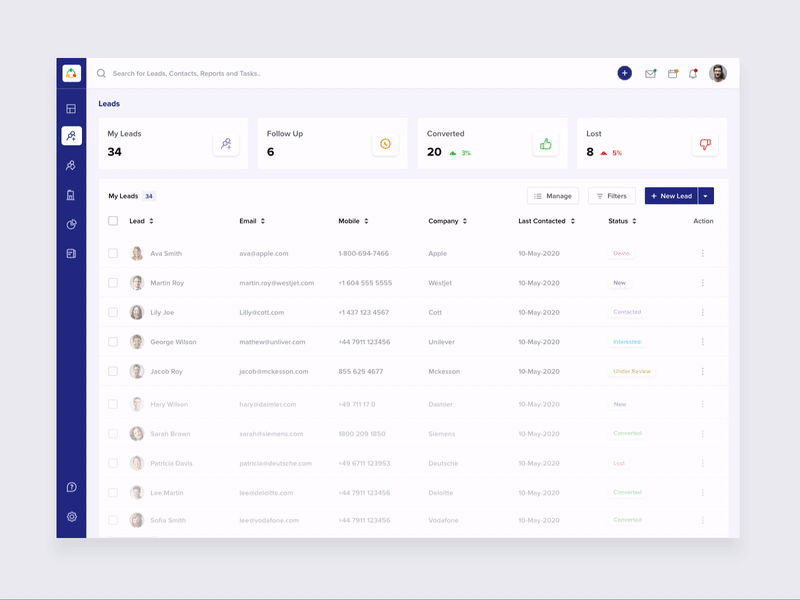Marketing technology (MarTech) is no longer optional: it empowers businesses to personalize customer journeys, automate marketing tasks, and unlock valuable data insights for maximized sales and growth. However, building high-performing MarTech apps for e-commerce can be a challenge.
This guide explores the intricacies of building MarTech & e-commerce software, highlighting the challenges, team structures, and innovative solutions like nearshore development to help software leaders achieve success.
Building MarTech Apps: Key Questions Answered
MarTech (Marketing Technology) empowers businesses to personalize customer journeys, automate marketing tasks, and gain valuable data insights. However, building high-performing MarTech apps for e-commerce can be challenging. Let’s dive into some key questions executives might have about building MarTech apps for e-commerce success:
Makes sense? Read on! We’ll delve into the benefits of nearshore development teams, explore the specifics of building MarTech & e-commerce software, and showcase strategies for building a successful development team.

Nearshore development builds powerful MarTech apps to personalize & automate your marketing. Photo by S O C I A L . C U T.
Whether you’re a CTO or software development manager, this guide will equip you with the knowledge to leverage nearshore development and unlock the full potential of MarTech for e-commerce businesses.
Specifics of Building Software for MarTech & E-commerce
Building software for MarTech & e-commerce requires a nuanced approach that considers various aspects beyond just technology. Here’s a breakdown of key specifics and how they impact software teams:
#1 Regulations (Compliance)
MarTech & E-commerce are subject to a moderate level of regulation, with the emphasis on protecting user data privacy and adhering to industry-specific regulations if applicable. Here’s a breakdown:
Data Privacy

For most e-commerce businesses, data privacy is the key regulatory concern. The level of compliance complexity can vary depending on the location of users and the type of data collected. However, it’s crucial to prioritize data security and user privacy to avoid hefty fines and reputational damage.
Regulations like GDPR (Europe) and CCPA (California) are the most significant compliance hurdles. These require robust data security measures, user consent for data collection, and procedures for handling user requests regarding their data.
- Engineering teams need to prioritize secure data storage solutions and implement robust access controls.
- Product and design teams need to ensure clear user consent mechanisms and easy-to-understand privacy policies.
Industry-Specific Regulations

It’s important to note that regulations are constantly evolving. Staying updated on the latest data privacy laws and best practices is essential for MarTech & e-commerce businesses.
Certain industries (healthcare – HIPAA, finance – FINRA) have additional data security and privacy regulations that MarTech & e-commerce software needs to comply with.
- All teams need to be aware of relevant industry regulations and incorporate them throughout the development process.
#2 Market Needs (Functionality)
Functionality is extraordinarily important for the MarTech & e-commerce industry. Here’s why:
Competitive Advantage

The e-commerce landscape is fiercely competitive. Businesses need feature-rich MarTech software to personalize the customer journey, automate marketing tasks, and gain valuable data insights. This functionality translates to:
- Enhanced User Experiences: Personalized product recommendations, targeted marketing campaigns, and user-friendly interfaces keep customers engaged and drive sales.
- Marketing Automation: Automating repetitive tasks like email marketing and social media scheduling frees up marketing teams to focus on strategic initiatives.
- Data-Driven Decisions: Powerful analytics features provide valuable customer insights that can be used to optimize marketing campaigns and improve product offerings.
To enable this,
- Product and design teams need to work closely to develop personalization algorithms and user interfaces that cater to individual customer preferences.
- Engineering teams need to integrate these features seamlessly with data sources.
Meeting Customer Expectations

Today’s online shoppers expect a seamless and personalized shopping experience. MarTech software with features like abandoned cart recovery and omnichannel marketing helps meet these expectations and convert website visitors into loyal customers.
- Abandoned Cart Recovery: Many potential sales get lost at the checkout stage. E-commerce apps should enable features like automated abandoned cart recovery emails with incentives to complete purchases.
- Product and marketing teams collaborate on crafting compelling recovery emails.
- Engineering teams build the automation workflows and integrate them with email marketing platforms.
- Omnichannel Marketing: Modern consumers interact with brands across various channels. Without proper functionality, delivering cohesive marketing messages across all touchpoints (website, mobile app, social media) becomes difficult. MarTech software bridges this gap and ensures consistent brand messaging for a more impactful marketing strategy.
- Product managers ensure consistent branding and user experience across all channels.
- Engineering teams build APIs and integrations to connect MarTech software with different marketing platforms.
In essence, robust functionality empowers MarTech & e-commerce businesses to deliver exceptional customer experiences, optimize marketing efforts, and gain a competitive edge in the marketplace.
#3 Stakeholders (Communication & Collaboration):
Building successful MarTech & e-commerce software requires a collaborative approach that considers the needs and priorities of various stakeholders. Here’s how each group influences product decisions and what success factors contribute to delivering better software:
Scope |
Mission |
Success Tactics |
| C-Suite Executives | C-Suite Executives set the overall vision and priorities for the software, focusing on business goals like ROI and competitive advantage. They also approve budgets and resource allocation. |
|
| Product Managers | Product Managers act as the central point of communication, bridging the gap between stakeholders and ensuring the software meets business needs, user experience, and technical feasibility. They define product roadmap and prioritize features. |
|
| Marketing Teams | Marketing Teams provide user stories and data insights based on customer behavior and marketing campaign performance. They advocate for features that enhance user engagement and campaign execution. |
|
| IT Teams | IT Teams weigh in on technical feasibility and ensure seamless integration of MarTech software with existing e-commerce platforms. They prioritize data security and system performance. |
|
By understanding these specifics and their impact on different software teams, e-commerce businesses can foster a collaborative development environment that builds powerful MarTech solutions tailored to market needs and user expectations.
#4 User Groups and Considerations
Understanding your target user group is crucial for building successful MarTech & e-commerce software. Here’s a breakdown of key considerations for different user groups:
Considerations for B2C vs. B2B Design & Development

Individual consumers shopping online for personal needs need user-friendly interfaces, engaging product discovery features (personalized recommendations, search filters), seamless checkout process, and mobile responsiveness for on-the-go shopping. We recommend you:
- Prioritize intuitive navigation, clear product information, and visually appealing interfaces.
- Integrate social proof elements (customer reviews, ratings) and loyalty programs to build trust and encourage repeat purchases.
- Optimize for mobile devices to cater to the growing trend of mobile shopping.
On the other hand, businesses or organizations purchasing products or services for their own operations have more complex needs:
- Secure account management features
- Role-based access controls
- Bulk ordering options
- Streamlined approval workflows
- Robust integration with existing business systems
To address this, you should:
- Focus on functionality and user efficiency.
- Design clear dashboards for account management and order tracking.
- Integrate with business communication tools used by B2B buyers (e.g., Slack, email automation).
- Ensure robust security measures to protect sensitive business data.
User Experience vs. Tech Proficiency

While technical expertise varies among users, e-commerce platforms should strive for a universally intuitive experience. Here’s how to cater to different technical skill sets:
- Limited Technical Savvy: Prioritize clear instructions, user-friendly navigation, and minimal learning curve. Offer context-sensitive help features and tutorials for users who need additional guidance.
- Tech-Savvy Users: Provide advanced features and customization options for users who appreciate a more feature-rich experience. Consider offering different user interface views depending on technical proficiency (basic vs. advanced).
Additional Considerations

By carefully considering these user group characteristics and tailoring the design and development process accordingly, MarTech & e-commerce software can provide a seamless and user-friendly experience for everyone, regardless of background or technical expertise.
- Accessibility: Ensure the software is accessible to users with disabilities by following WCAG (Web Content Accessibility Guidelines) standards. This includes features like screen reader compatibility and keyboard navigation.
- Localization: For global e-commerce businesses, consider offering localized versions of the software with language and cultural adaptations to cater to international audiences.
3 Types of MarTech & e-Commerce Software:
This section will showcase various MarTech software solutions relevant to e-Commerce, with details on their impact on development teams:
#1 Customer Relationship Management (CRM) Systems

CRM systems track and manage interactions
CRMs manage customer data for targeted marketing campaigns. Clothing brands can use CRM data to send personalized discount offers based on purchase history, for example.
Thus, the most frequent requirements are secure data storage, integration with marketing automation tools.
- Product: Develops features for data import/export and segmentation.
- Design: Creates user-friendly dashboards for data visualization.
- Engineering: Integrates CRM with marketing automation tools.
#2 Marketing Automation Software
Marketing automation streamlines activations.
This kind of software automates repetitive marketing tasks like email campaigns and social media scheduling. A tangible use case would be an e-commerce store that uses automation to send abandoned cart recovery emails.
Although user-friendly interface for campaign creation is important, the priority is providing robust analytics for performance measurement.
- Product: Develops workflow automation features and reporting tools.
- Design: Designs intuitive email templates and landing pages.
- Engineering: Integrates automation tools with e-commerce platform.
#3 Personalization Engines

AI has been making personalization engines smarter.
Personalization Engines tailor the customer experience based on individual preferences and behavior… think of a beauty store that regularly recommends products based on a user’s past purchases.
For these applications, AI capabilities for data analysis and recommendation generation, real-time integration with customer data are must-haves.
- Product: Develops algorithms for product recommendations and content personalization.
- Design: Creates dynamic layouts for personalized website experiences.
- Engineering: Integrates personalization engine with e-commerce platform and CRM.
How to Build High-Performance MarTech & E-commerce Technical Teams: Roles, Skills & Strategies
Building a successful MarTech development team requires careful consideration of various factors. You’ll need to identify the right roles with the appropriate programming languages and expertise in relevant tech stacks like MarTech tools and e-commerce platforms. Additionally, fostering a collaborative environment between your in-house team, the marketing team, and any potential Nearshore App Development for MarTech and e-Commerce Companies is crucial.
The success of MarTech & e-commerce software hinges on a well-rounded technical team with expertise across various disciplines. Regardless of the engagement model, here is a breakdown of key roles, desired skills (both hard and soft), and strategies for building a high-performing team:
Core Roles and Respective Hard Skills
Full-Stack Developer

Every profession has a “know-it-all” position, and in app development this comes in the form of a Full Stack developer.
- Proficiency in programming languages (e.g., Python, Java, JavaScript) and frameworks (e.g., Django, Spring, React).
- Experience with APIs, databases (SQL & NoSQL), and cloud platforms (AWS, Azure, GCP).
- Understanding of security best practices.
- In addition to the general skills mentioned, proficiency in e-commerce frameworks like Magento or Shopify would be a plus.
- Experience with marketing automation platforms (e.g., Marketo, HubSpot) and CRM (Customer Relationship Management) systems is valuable for building integrations.
Front-End Developers

Frontend Engineers and Developers bridge the gap between design and functionality, ensuring your software not only looks great but also functions flawlessly
- Expertise in HTML, CSS, and JavaScript (including frameworks like React or Angular).
- Strong user interface (UI) and user experience (UX) design principles.
- Responsive design for optimal mobile and desktop experiences.
- Understanding of e-commerce design best practices, such as product page optimization and A/B testing for user experience improvements.
- Familiarity with personalization techniques like dynamic content and product recommendations.
Back-End Developers

Backend Engineers enhance functionality and power server-side logic and databases, ensuring that data and requests flow seamlessly.
- In-depth knowledge of server-side technologies and database management.
- Familiarity with DevOps practices for continuous integration and deployment.
- Experience with building secure APIs for data exchange between MarTech tools and the e-commerce platform.
- Knowledge of data warehousing and analytics platforms for handling customer data collected through MarTech tools.
QA Testers

QEs and QAs collaborate with developers to integrate testing into the software development lifecycle
- Strong understanding of software testing methodologies (manual & automated).
- Experience with testing tools (e.g., Selenium, Cypress).
- Attention to detail and a keen eye for catching bugs and usability issues.
- Experience with testing e-commerce functionalities like shopping cart, checkout process, and payment gateways.
- Familiarity with accessibility testing for users with disabilities.
Soft Skills for All Team Members
- Communication and Collaboration: Effective communication across teams (engineering, product, marketing) is crucial for understanding requirements and delivering successful software.
- Problem-Solving and Critical Thinking: The ability to identify, analyze, and solve complex technical challenges is essential.
- Adaptability and Continuous Learning: The MarTech & e-commerce landscape is constantly evolving. Team members should be adaptable and embrace continuous learning to stay up-to-date with the latest technologies and trends.
- Data-Driven Decision Making: The ability to analyze data and translate insights into actionable development decisions is valuable for optimizing software performance and user experience.
Strategies for Building a High-Performance MarTech & E-commerce Technical Team
The success of MarTech & e-commerce software hinges on a well-rounded technical team with expertise across various disciplines. Here’s a breakdown of key roles, desired skills (both hard and soft), and strategies for building a high-performing team.

A Tech Lead isn’t just a guide but an inspiration – someone who not only ensures that the project stays on track but also leads the team with a vision of distinction.
4 Steps Toward Building a High-Performance Team
Optimizing Your Team Structure

“Figure what each person does and what drives them”, Sam Marx prompts us. “Who are people, what makes them tick? Mission, money?”
Businesses often struggle to find the right talent with the necessary skill sets for MarTech development or face limitations due to budget constraints. This is where nearshore software development services can offer a compelling solution.
While building a strong in-house MarTech development team is crucial, here’s how you can leverage additional resources to further enhance your development capabilities:
- Nearshore Software Development Outsourcing: Partnering with a nearshore development team can provide access to a wider talent pool with relevant MarTech & e-commerce experience, often at a more cost-effective rate compared to local hiring. This allows you to scale your team efficiently and bridge any skill gaps.
- Staff Augmentation: Bringing on temporary or contract workers with specific MarTech & e-commerce expertise can be a strategic solution for tackling short-term projects, or addressing specific skill deficiencies within your in-house team by adding dedicated team members that for the long run.
- Incorporating AI into MarTech & E-commerce Development: Leveraging AI tools like machine learning can streamline tasks such as data analysis, personalization recommendations, and automated testing. This frees up your team to focus on more strategic initiatives and enhance overall development efficiency.
Ubiminds can help you achieve all of this and more! We provide expert consultancy services, seamless implementation of your MarTech vision, and access to a dedicated pool of highly skilled Latin American MarTech & e-commerce development talent. Contact us today to discuss how we can empower your business with a high-performing technical team!

International Marketing Leader, specialized in tech. Proud to have built marketing and business generation structures for some of the fastest-growing SaaS companies on both sides of the Atlantic (UK, DACH, Iberia, LatAm, and NorthAm). Big fan of motherhood, world music, marketing, and backpacking. A little bit nerdy too!


